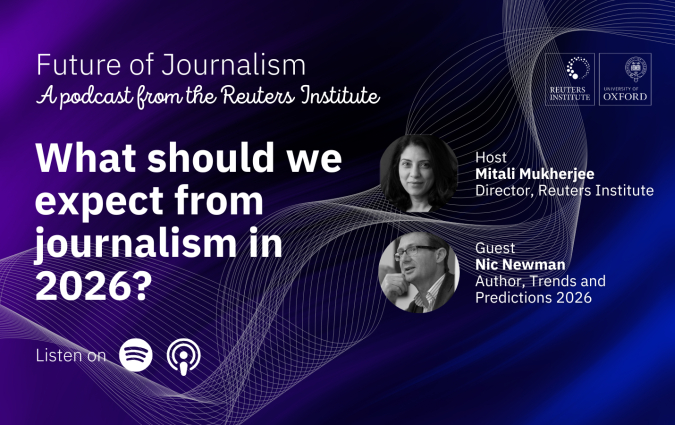Journalism is under attack. Here's how it must fight back

Argentine journalists protest police action outside Argentine Congress in Buenos Aires in 2017. / REUTERS/Martin Acosta
This is a lightly-edited version of Meera Selva's lecture at the International Journalism Conference organised by FOPEA in Buenos Aires. Meera is the Director of our Fellowship Programme. Before taking this role, she reported from London, Africa, Berlin and Singapore on terrorism, refugees and the financial crisis.
We are now at a moment where journalism, everywhere, needs to define itself. We need to define what we stand for, who we speak for and who we speak to, and how we defend ourselves.
Journalists and journalism sit both inside the rooms of power and outside. The media is both an incredibly powerful, unaccountable force and a vulnerable, financially weak institution under attack from politicians, from platform companies like Google and Facebook and from readers themselves, who see no reason to buy a daily newspaper or pay for a digital subscription.
This is an incredibly difficult time to be a journalist. Thirty-seven journalists have been killed this year, including Lyra McKee in the United Kingdom, murdered in Northern Ireland. 233 journalists and 124 citizen journalists have been imprisoned.
Even more worrying is the general poisoning of the relationship between journalists and the public, whether it is through vicious online attacks on journalists, or journalists being attacked by protestors when they go to report on demonstrations. In the end this all creates an atmosphere that makes journalists and the media incredibly weak. And I think it is absolutely vital to its survival that we address all this head on.
What I would like to do is raise six areas where I think there are real threats to journalism and hopefully raise some solutions too.
1. Digital disruption.
It is clear to everyone by now that the idea of the media as a social institution, acting as gatekeepers of information, to communicate the values of the dominant culture, is changing.
At the Reuters Institute we have the Digital News Report that looks at news consumption patterns in 38 countries around the world. Our data shows that two thirds of online news users access the news through side-door access – whether that is search engines, social media, email newsletters or mobile alerts. Among those under 35, this figure is even higher. Three quarters use side door access for news.
Politicians who have may have mistrusted journalists but understood that they needed them to communicate with voters are now willing to openly attack and dismiss them, and use social media to talk directly to their supporters instead.
US president Donald Trump uses his Twitter account to spread his own message and discredit the media, and it is a tactic used by strongmen worldwide. It is no surprise that outside the United States, the two politicians with the most followers on twitter are the Hindu nationalist Narendra Modi and Turkey’s Recep Tayyip Erdogan.
2. Loss of trust.
The big battle for journalism is to persuade people to spend time with the news and to help pay for it. This won’t happen if they don’t trust us.
Our Digital News Report, which tracks patterns of media consumption in 38 different countries, shows that only 42 percent of digital news users trust news worldwide, down 2 percentage points from last year. Less than half (49 percent) trust the news they use themselves.
In some countries, this fall in trust has been precipitous, and has accompanied a rising mistrust in all institutions. In France, the Yellow Vests movement pushed trust in media down 11 percentage points to 24 percent. In the UK trust in news overall is at 40 percent, but people do at least have a bit more faith in the news they choose to consume, with 51 percent saying they trust the news they use.
One slight consolation in this is that trust in the most reputable brands –in many cases legacy media, is rising, as people grow more mistrustful of what they consume online.
When people consume news online, they are not always aware of the source of their news and it is not always easy to distinguish between reputable and non reputable sources. If they feel that the news they are reading is inaccurate, irrelevant or biased, they come away with a sense that all the news is not to be trusted. This is amplified by those like Mr. Trump, who uses the term fake news to discredit all critical media.
There are also a lot of questions about who and what should be considered a publishing platform, and how the space should be regulated now.
3. Bad regulation.
And there is no consensus on how technology companies should be regulated even though there is a general acceptance that they are taking on many of the roles of traditional publishers.
It is clear that the current regulatory environment is not working, partly because in an increasingly polarised society, concepts such as bias, balance and impartiality are hard to define. Also because in the digital space, newspapers frequently carry video and audio recordings on their websites, and broadcasters accompany their videos online with large bodies of text.
There is still no real consensus on how the technology companies that distribute so much of our news should be regulated. Europe is minded to treat them as publishers and regulate them as such. This could work in countries where there are other guarantees of free speech. In other places, it could be devastating.
This is a particularly sensitive time globally. The internet in much of the world is still about freedom, about finding a new platform on which to build. There are radical feminist groups reaching young women on Instagram, and kids sharing videos on climate change via Tik Tok.
However, amid this new freedom there are very real fears about misinformation and trolling, and some people say that something must be done. I used to live in Singapore. It was always an authoritarian, heavily censored state. It also became the first country to adopt Fake News Laws, which have been very predictably used to stop critical voices, even those originating abroad.
4. Financial pressures.
The media is having to adapt to fast changing circumstances in an ever tightening financial environment.
The traditional model of advertising revenue supporting independent journalism is fading fast. This is hitting newspapers in India, a country that still has newspapers with large print circulations. It has also hit newspapers in Europe and the US like a juggernaut. The digital advertising that has replaced print advertising has gone mainly to platforms like Google and Facebook, which can offer a far more precise and up to date data on their audiences than media houses can.
So in a climate of layoffs, falling revenues and fierce competition from newcomers, media houses must find a way to invest in new technologies, stay relevant, and fight off harmful regulation.
One obvious way of doing this is by connecting with its audiences. Many publishers have decided this year to focus on subscriptions and memberships as a significant source of revenue, in the hope that it will eventually help replace falling display advertising. This is about more than simply asking readers for subscriptions- it is about asking them to buy into the brand.
The Guardian, which has always kept its online content free, has launched a successful membership model, where it asks readers to pay for its journalism, not so they can have exclusive access to it, but so they can ensure The Guardian’s reporting is available to everyone. Other organizations such as Tortoise, the media start-up launched by James Harding, the former editor of The Times, is building membership around events and a two-way conversation with its readers – the idea is that readers expertise and experiences feed into the journalism.
Mediapart, eldiario.es, Tiempo Argentino have all made pacts with their readers: we will be totally transparent about our funding, our processes and our decision making. In return, please trust us and support us.
5. Bad journalism.
Journalists and editors need to constantly assess what and who they are for. Part of this will come from making sure journalists are truly representative of society, in terms of gender, race and socio-economic backgrounds. Our stories must reflect this diversity too.
We should also think hard about what news is meant to do. It is not just about presenting the facts but about helping people make sense of the world around them so they make informed choices about how to vote, where to send their children to school, and how to engage in civic life. Journalism should be about providing entertainment and empathy for others too.
This is vital in this climate. When the public say they are concerned about fake news, what they often mean is that they are concerned about partisan journalism, propaganda, or simple human mistakes.
Newsrooms in the more traditional media houses can also be quite elite –full of well educated people from financially stable backgrounds. A newsroom that is not diverse simply cannot tell the whole story of any country. You will literally get the news wrong,
6. Institutional paralysis.
This is a problem but it is also one that we can definitely do something about. Media organizations are companies like any other but ones that have often been spectacularly bad at adapting to change.
We are inherently competitive, with big egos and a very clear idea of the kind of stories we want to write.
Legacy newsrooms are slow to invest in digital media because there is still money in print. But that money will run out eventually. And when it does, it will be the young journalists, with no pensions and no savings, who are hit the hardest.
It’s not always clear how and when things should change, and we will all make mistakes along the way but change is coming whether we like it or not. And that is where our biggest opportunities lie if we embrace it.
If you want to explore the future of journalism with us, join our weekly newsletter in this link.




